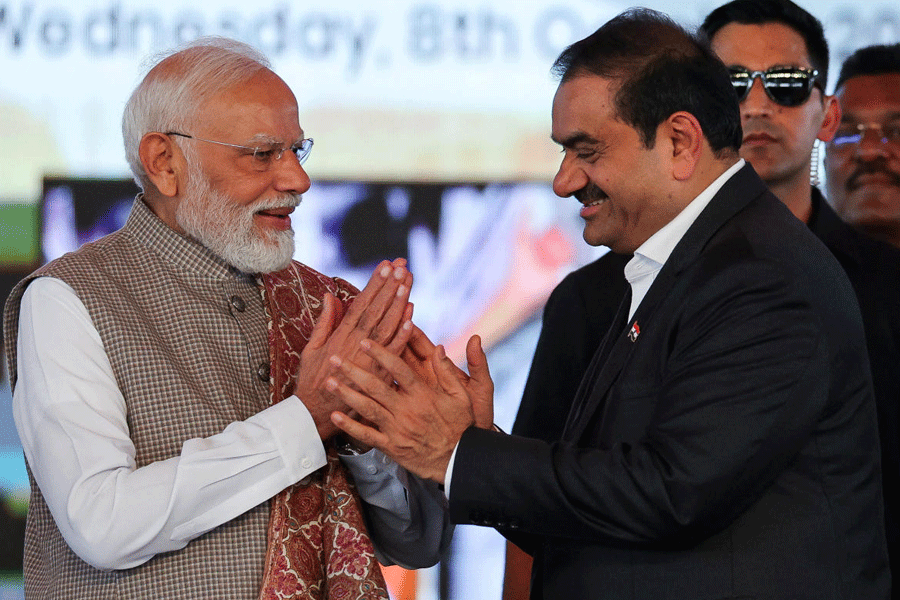 |
| DECAYED TREASURE: (Top) Egyptian expert Tarek-el-Awady and Chenna Reddy (right), director of the Hyderabad museum, inspect Princess Nasihu’s mummy; (Below) the sorry state of the mummy at the Lucknow museum |
 |
The Egyptian mummy enjoys pride of place at the magnificent Indo-Saracenic style Government Central Museum in Jaipur. And deservedly so. Placed in a hall with a high ceiling and a sun roof, the mummy draws crowds throughout the day and is without doubt the star attraction of the museum.
A small metal board placed on the floor states that the mummy is that of Tutu, a teenaged girl who was a member of a priest’s family belonging to the Ptolemaic period in Egypt (322 BC to 30 BC).
“The mummy is the most popular of all the items displayed in our museum,” says a beaming S.P. Singh, director of the museum.
But Tutu may lose that distinction soon. That’s because its condition has badly deteriorated over the years. Its ochre coloured shroud is so frayed that its linen cloth bandage is visible from the outside. At some places one can even see the mummy’s body tissue and skeleton.
Yet it is evident that Tutu’s mummy was once splendidly embellished. A gilded mask painted in gold, black and white covers its face and neck. A few inches below the mask is the painted wsekh, a cloth covering the entire chest area. A large winged scarab beetle is painted on top of the wsekh and a painted necklace adorns the lower part. There are also decorative figures of gods and goddesses painted in yellow, white, red and black. But the wsekh too is severely damaged, as is the lid of the mummy’s sarcophagus (kept suspended) where the carvings and paintings can hardly be discerned anymore.
This mummy, one of only six in India, came to the country in 1883 when it was “gifted” by Brughsch Bey of the Museum of Cairo for an exhibition in “Jeypore”. But with almost no major restoration or preservation efforts in all these years, Tutu’s mummy is in need of immediate care.
In fact, Nassry Youssef Iskander, an Egyptian expert on preservation of mummies who visited the Jaipur museum in 1999, had recommended urgent restoration work on the mummy, and had called for “serious conservation action”. Yet nothing has been done since then.
Of course, the mummy in Jaipur is not the only one in India to have been neglected. Mummies in museums in Hyderabad, Lucknow, Mumbai, Baroda and Calcutta all need to be preserved. In fact, the ones in Hyderabad and Mumbai have deteriorated so much that they are not even shown anymore.
Arun Arya, head of the department of botany at M.S. University, Baroda, who did a study of the Egypto-Babylonian Gallery at the Baroda Museum and Picture Gallery in 2001, says that mummies in India are in a “pathetic” condition.
According to Arya, few museums outside Europe and America possess Egyptian mummies. “The mummies are a part of world history and we should be proud that we have these slices of history in our museums,” he says. “But the museums only gloat over their mummies. They are simply not interested in preserving them.”
In his study of the mummy in Baroda, Arya noted, “A few decades back, somebody had cut the linen cloth layering on the right foot so that visitors could have a clearer look at the toes of the mummy.” The exposed toes have now developed white, fungal patches. Arya even noticed insect holes on the mummy’s wooden sarcophagus.
But R.D. Parmar, director, Baroda Museum and Picture Gallery, doesn’t see any “problem” with the mummy. “We are preserving it very well. It will last forever,” he asserts.
The mummy in the Andhra Pradesh State Museum in Hyderabad is no better off. In fact, Tarek-el-Awady, director of scientific research in The Supreme Council of Antiquities in Cairo, who visited the museum last year, advised it to stop displaying the mummy.
The linen wrappings of Princess Nasihu’s mummy have turned yellowish and the outer layer is badly damaged. The broken face mask reveals the mummy’s skeletal chin and the wrappings around the feet are torn.
“We probably have the best decorated mummy in the country, but it has not been preserved well. However, we are very serious about preserving the mummy now,” says Chenna Reddy, director, Andhra Pradesh State Archaeology and Museums, Hyderabad.
The condition of the 3000-year-old mummy of a teenage girl in the Lucknow museum is probably the worst — it looks almost like a corpse that has been recently exhumed. The linen wrappings have turned black and are almost completely worn out. One can also see the dark hair on the skull jutting out from under the wrappings.
But the Lucknow museum dismisses the charge that its prize exhibit is in immediate need of restoration. “The mummy is in a very good condition and there is no need for any more preservation right now,” says museum director Rakesh Tiwari.
As for the mummy in Mumbai’s Chhatrapati Shivaji Maharaj Vastu Sangrahalaya, no one knows precisely what state it is in as the authorities are tight-lipped about it. All that is known is that it is not on display because it’s in a bad condition.
Reddy rues the fact that there isn’t a single Egypt expert in India trained in the art of preserving mummies. “Had there been one, our mummies wouldn’t be in such a pathetic state,” he says.
Of all the museums in the country, the one at the Indian Museum, Calcutta, is probably the best preserved. It is kept in an air-conditioned room and the air is regulated even within the glass chamber.
According to P.K. Dutta, in charge of preservation at the Calcutta museum, the mummy is dusted once a week with a soft hair brush. “The museum takes a ‘don’t touch’ approach towards maintaining the mummy,” says Dutta.
The Calcutta mummy was one of the earliest mummies to come to India. It was brought by an Englishman from Egypt in the 1880s. The mummy in Baroda was bought by its ruler, Sayajirao Gaekwad III, for $175 from a New York Museum in 1895. Hyderabad royal Nazeer Nawaz Jung purchased the one showcased in the city museum for £1000 in the 1920s.
Mummies do “age” and will suffer wear and tear if handled carelessly. However, damage can be slowed down by controlling such agents of deterioration as high, low or fluctuating relative humidity, high temperatures, light, pollution, dust, insects and so on. “Storage in cool, dark, oxygen-free conditions would theoretically preserve an object indefinitely, but achieving these conditions is extremely expensive and difficult to maintain in the long term,” says Tracey Seddon, senior organics conservator, National Museums, Liverpool, England.
In the West, most museums use oxygen-free glass chambers — which cost around Rs 20 lakh — to preserve mummies. But none of the Indian museums has such a facility. Arya, who has been to several museums around the world, says Italy’s Turin Museum, which houses scores of Egyptian mummies, could be a perfect model for museums in India to follow. “All the mummies are preserved in oxygen-free chambers. Moreover, they are displayed in low lit galleries where no photography is allowed,” says Arya.
In contrast, except for the Indian Museum in Calcutta, all other mummies in India are kept in brightly-lit chambers and photography is not prohibited.
Still, some are making an effort to contain the damage. For example, the Hyderabad museum is trying to restore its mummy to its former glory. “We are obtaining an oxygen-free chamber soon, and we will request the Egyptian expert to visit us again and restore the mummy,” says Reddy. “I hope other museums follow our example,” says Reddy.
If they don’t, museums in India stand to lose some of their most prized exhibits.











